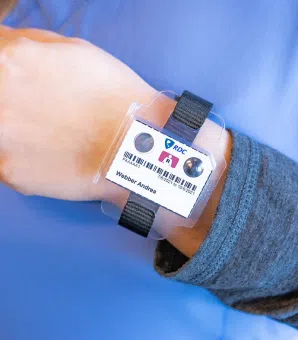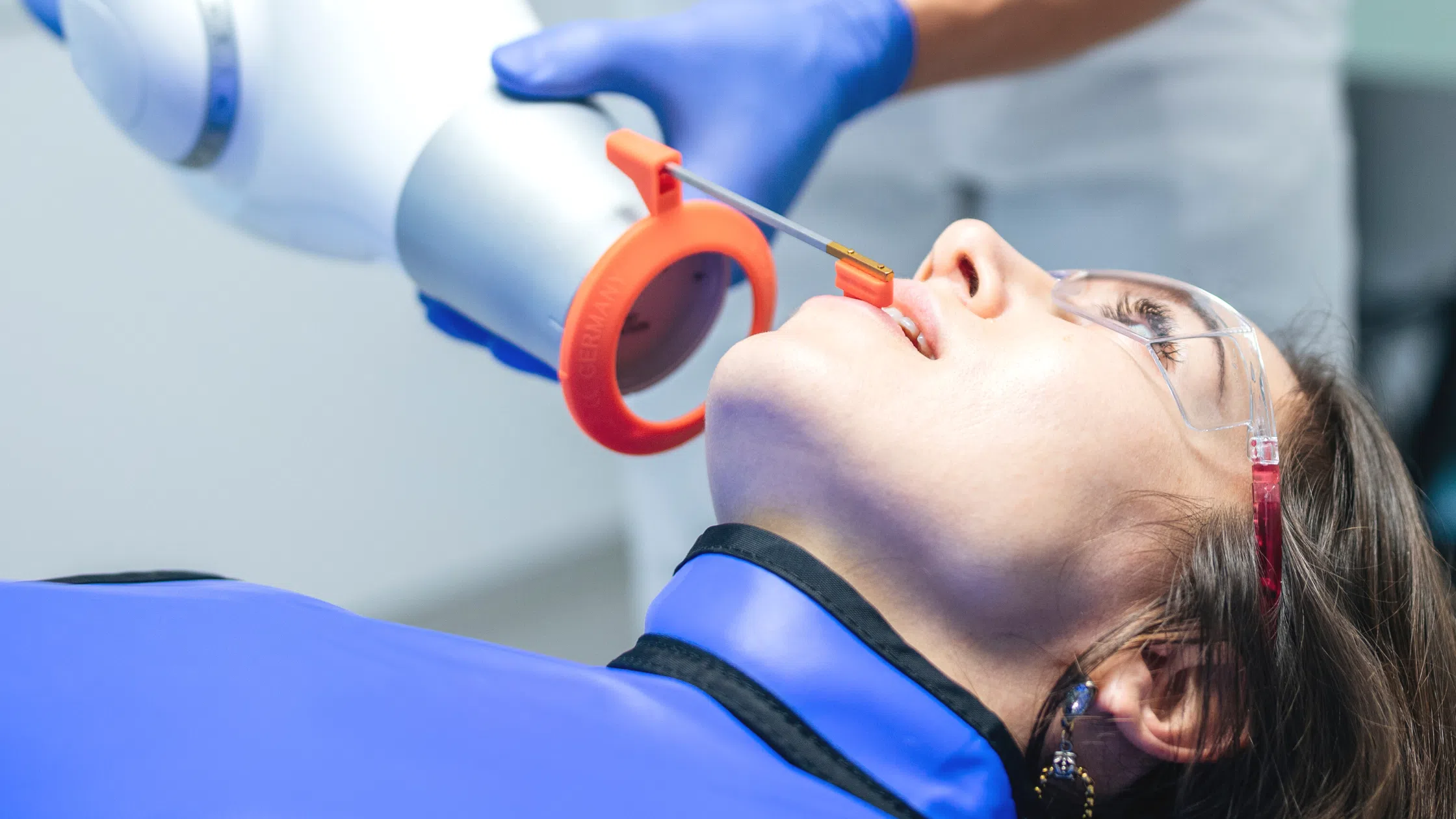
Dosimeter badge services for medical, dental, and veterinary businesses
Learn how Radiation Detection Company’s easy-to-use dosimetry solutions can boost the efficiency of your practice.
X-rays are a daily occurrence for both staff and patients in the dentist office. For this reason, dental offices that make use of a handheld x-ray unit typically require radiation monitoring. When using handheld devices, safety is of the utmost importance. If an error or malfunction were to occur, it poses a greater safety risk to the worker than a conventional x-ray method. This greater risk is due to the fact that the workers cannot distance themselves from the device (as they can with a conventional dental x-ray method).
While handheld devices typically feature a lower output dose rate, taking the necessary safety measures are crucial.
In this article, we will discuss radiation safety in the dental office setting, protections & liability, available technology, and recommendations & solutions.
The main principle of radiation safety is referred to as “ALARA.” ALARA is an acronym that stands for “as low as reasonably achievable.” This means that the goal of a radiation safety program is to keep worker radiation doses as low as possible.
A well-established radiation safety program provides credibility for the organization, while also providing employees with peace of mind. By monitoring both your employees and the area for radiation exposure, a hazardous situation can be quickly detected and acted on.
If radiation monitoring (area and personnel) is not happening, you may not realize something is wrong with your x-ray machine. Without monitoring, it's very difficult to ensure your employees are choosing the position of minimum exposure during patient treatment.
To accomplish the goal of avoiding the hazards of radiation exposure, there are three basic protective tenets:
Time refers to how long personnel spend near a source of radiation. The amount of time should be minimized whenever possible, while still allowing the worker to accomplish necessary tasks.
Distance refers to the proximity to a source of radiation. The distance should be maximized whenever possible, as increasing the distance leads to a decreased radiation dose.
Shielding refers to putting something between you and the source of radiation. Whether it be a wall, protective clothing, or other safety equipment.

For more information on the importance of a radiation safety program, please check out our recent article. "Radiation Safety Programs: A Comprehensive Guide."
Personnel workload optimization without the monitoring or tracking of who is receiving exposures (or using the number of X-rays taken) makes it hard to determine if workers are staying below the recommended number of X-rays per year (to ensure monitoring is not required).
If workload is above 100 intraoral or 50 panoramic films per week it may be likely to exceed (100 mrem/year).
From insights gathered, many dental office owners, managers, and dentists are reluctant to spend the funds towards radiation monitoring. While some may think it's unimportant, others don't see that a simple dosimetry solution can be easy. This creates a major concern for personnel throughout the industry.
People who are diagnosed with cancer sometimes assume that the cancer was caused by occupational exposure (the radiation dose received in the workplace). Usually those in this situation are upset and are looking for someone to blame. In these instances, the employer generally should be able to provide the dose to any current or former employee that had a chance of being exposed to radiation, even if doses are low within the practice.
A reading of “minimal” or low recorded doses becomes very important objective evidence down the road if someone were to be diagnosed with cancer.
Those who have been involved in a radiological accident (machine or procedure malfunctioning) could become upset. They may think that they received additional dose due to radiation leakage. Flaws in head/applicator shielding, lack of appropriate head/applicator shielding, or an incorrectly positioned x-ray tube insert can lead to increased radiation leakage as well as the potential for increased out-of-field patient dose.
With the increased use of Cone Beam CT (CBCT), the probability of this occurrence is markedly higher than in the past.
Pregnant radiation workers who miscarry or those who give birth to disabled children may wonder if their occupational exposure could be the cause. For all the potential situations detailed above, proper monitoring can protect an employer against liability and litigation.
In this way, a relatively small investment in monitoring for the organization can prevent the potential for a much larger capital expenditure down the road.

When used appropriately, digital x-ray equipment does provide less dose to the patient and users. However, if just switching from film to digital and not setting up the x-ray system to reduce the dose and x-ray energy, the dose reduction will not be realized.
Studies indicate a potential dose reduction between 40-75% when switching from film to digital imaging. But additional studies indicate that the patient dose can vary up to a factor of 17 if the x-ray unit is not set up correctly for the new digital technique.
The changing image capture settings used in Cone Beam CT units introduces a new radiation environment into the workplace. Monitoring should always be reevaluated when new technologies are deployed.
There are two main well-respected and recognized groups that recommend radiation monitoring in the dental office setting. These groups are the American Dental Association (ADA) Council on Scientific Affairs, and the International Dental Association (FDI).
The Arizona Smile Center describes NOMAD x-ray units as, "A handheld, battery-powered intraoral x-ray system that produces high-quality radiographs with digital sensors and phosphor plates. Digital radiography (digital x-ray) is the latest x-ray technology used to take dental x-rays.”
The NOMAD x-ray unit utilizes the latest x-ray technology to both preserve the quality of your images and deliver exact and repeatable exposures with outstanding image quality. Its ergonomic design makes the device more stable in your palm (due to shape and weight dispersion).
Handheld x-ray units can result in more mobility. Which can lead to a greater potential of irradiation of coworkers (scatter radiation) than fixed units in confined spaces. However, a more relaxed radiation safety posture has been observed when these units are in use. This poses a threat to personnel.
In dental settings, PSP or sensor modality are two common techniques for generating x-ray imagery.
Photostimulable phosphor (PSP) plates are still very commonly used as receptors in intraoral radiography. PSP allows for indirect digital image acquisition. This means after the exposure, a latent image occurs on the plate, and it is then converted to a digital radiographic image via a scanning device.
A digital intraoral sensor is a small device that is used to capture x-ray images. Instead of using a heavy vest to protect against radiation and being situated in a large intense machine, patients can remain in their exam chair while the sensor is inserted into their mouth.

If the main concern is cost, we can switch personnel in an organization to a longer frequency (semiannual or annual), and potentially keep area monitors on a shorter frequency. The dosimeters on shorter frequency will have the ability to identify any unexpected situations.
If the main concern is logistics, we can recommend the use of digital dosimeters, which do not need to be shipped back and forth. An added bonus to digital dosimeter usage is that the dose reports are very simple to understand, and any exceptions can be more easily highlighted.
Want to take the next step in getting your dental office or organization set up with RDC’s radiation safety products? Please visit our Solutions page to view our full suite of offerings. We offer a wide range of affordable and comprehensive solutions to fit the needs of any organization, large or small. Have a question that we did not address in this article? Please reach out to our Customer Care team, and one of our specialists will be happy to assist you.
Learn how Radiation Detection Company’s easy-to-use dosimetry solutions can boost the efficiency of your practice.
